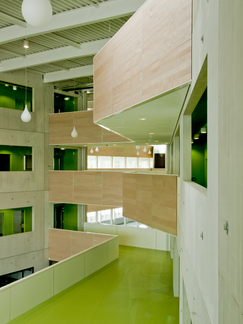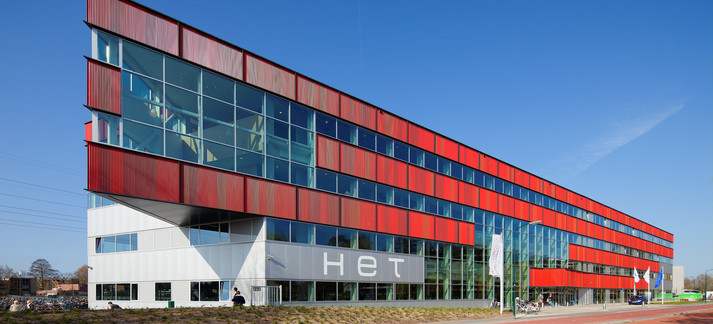-


School Het Perron
Educational theories seem to be one of the fastest changing areas of modern life, as educators struggle to help young people fit themselves to our evolving and challenging world. How then can an architect design a building that will stand for at least 30 years, and accommodate change of which we have not even dreamed?
Images courtesy of ZEEP architecten Amersfoort, Sigrid Schaap, Mark van den Boorn
Architect ZEEP architecten, Amersfoort (Jan Poolen, Stephan Sarphatie & Maarten Veerman) Location Veenendal - The Netherlands Company involved Tata Steel Website http://www.colorcoat-online.com
This is the challenge that faced ZEEP Architecten when designing a new school, ‘Het Perron’ in Veenendaal in the Netherlands. Fortunately it is an issue to which the architect has given some thought, and it based its design on the ‘living building concept’, the idea of a building that could, says the practice’s Jan Poolen, ‘change with the changes in education, or easily become another building altogether.’ This was achieved by the use of a column-free plan, so that the interior of the light-filled building could be rearranged as easily as possible. It was also reflected in the way that the building was designed, to ensure that the client was as happy as possible with the building at the start. ‘We used BIM (building information modelling)’ said Poolen, ‘which meant that at any time it was possible for the client to look at the model and see if the designs worked with their way of designing education.’
Anybody who fears that this cooperative and flexible approach would result in a bland building, need only look at Het Perron to be disabused. Set on a triangular site, it brings together two different schools (‘Het Perron’ means ‘the platform’ and it is providing a common platform for education). This is symbolised by a design that looks as if two buildings are crashing into each other, with the corner of one protruding over the flat face of the other. The two ‘buildings’ (in fact of course only one) are differentiated by the cladding, with one in a plain anodised aluminium, and the other in shaded bands of red and brown, vaguely reminiscent of a bar code but less frenetic. It uses four different colours and is in fact, says Poolen, ‘the pattern of a heartbeat’. The building had a low budget, and so made use entirely of available materials, avoiding the use of specials. The cladding was no exception, so that the colours used were all standard colours, although employed in a non standardised fashion.
The building is of prefabricated concrete construction, with a high-quality finish which allows it to be exposed internally. Inside the space created where the two volumes crash is used as a community space, surrounded by balconies, some of which are faced in timber, to add a little warmth. There are also some bright pops of colour – an information booth in scarlet, a kitchen space in cobalt blue with a canopy above to create a sense of greater intimacy, and a wall of classrooms, visible from the main space and all fronted in emerald green. This space also has one of those wide staircases designed not just for circulation but for meeting and congregation which is becoming almost a cliché in education buildings – but a very welcome and attractive cliché. Beyond this space are two rectilinear blocks to provide the standard shapes of rooms that are the most flexible and adaptable.
While the architectural aficionado may admire the clever geometry and the quality of the finishes, for the users of the building it will simply be a bright and welcoming space, and one that is very easy to read. As the inhabitants of the two schools come together, there is no danger of them getting lost in their new environment. This is exactly the way that the architect wants it to be seen. ‘There is a close relationship between the building, the architecture and the users,’ said Poolen.
And similarly, although high standards of insulation etc. mean that this building ticks all the boxes on sustainability, the true sustainability will only reveal itself over time. ‘This is a very sustainable building because it is so easy to change to accommodate changes in education,’ said Poolen.
Images courtesy of ZEEP architecten Amersfoort, Sigrid Schaap, Mark van den Boorn













